Honoré Daumier
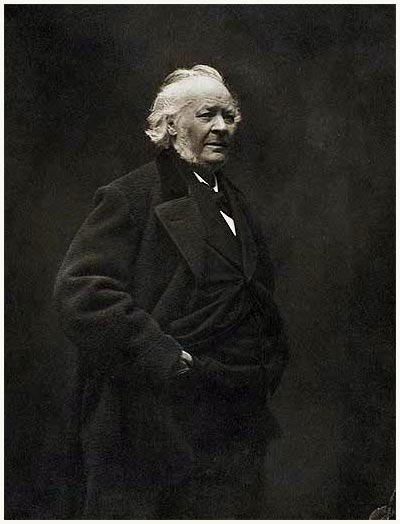
As we attempt, at the present day, to write the history of everything, it would be strange if we had happened to neglect the annals of caricature; for the very essence of the art of Cruikshank and Gavarni, of Daumier and Leech, is to be historical; and every one knows how addicted is this great science to discoursing about itself. Many industrious seekers, in England and France, have ascended the stream of time to the source of the modern movement of pictorial satire. The stream of time is in this case mainly the stream of journalism; for social and political caricature, as the present century has practiced it, is only journalism made doubly vivid.
The subject indeed is a large one, if we reflect upon it, for many people would tell us that journalism is the greatest invention of our age. If this rich affluent has shared the great fortune of the general torrent, so, on other sides, it touches the fine arts, touches manners, touches morals. All this helps to account for its inexhaustible life; journalism is the criticism of the moment at the moment, and caricature is that criticism at once simplified and intensified by a plastic form. We know the satiric image as periodical, and above all as punctual—the characteristics of the printed sheet with which custom has at last inveterately associated it.
This, by the way, makes us wonder considerably at the failure of caricature to achieve, as yet, a high destiny in America—a failure which might supply an occasion for much explanatory discourse, much searching of the relations of things. The newspaper has been taught to flourish among us as it flourishes nowhere else, and to flourish moreover on a humorous and irreverent basis; yet it has never taken to itself this helpful concomitant of an unscrupulous spirit and a quick periodicity. The explanation is probably that it needs an old society to produce ripe caricature. The newspaper thrives in the United States, but journalism languishes; for the lively propagation of news is one thing and the large interpretation of it is another. A society has to be old before it becomes critical, and it has to become critical before it can take pleasure in the reproduction of its incongruities by an instrument as impertinent as the indefatigable crayon. Irony, skepticism, pessimism are, in any particular soil, plants of gradual growth, and it is in the art of caricature that they flower most aggressively. Furthermore they must be watered by education—I mean by the education of the eye and hand—all of which things take time. The soil must be rich too, the incongruities must swarm. It is open to doubt whether a pure democracy is very liable to make this particular satiric return upon itself; for which it would seem that certain social complications are indispensable. These complications are supplied from the moment a democracy becomes, as we may say, impure from its own point of view; from the moment variations and heresies, deviations or perhaps simple affirmations of taste and temper begin to multiply within it. Such things afford a point d’appui; for it is evidently of the essence of caricature to be reactionary. We hasten to add that its satiric force varies immensely in kind and in degree according to the race, or to the individual talent, that takes advantage of it.
I used just now the term pessimism; but that was doubtless in a great measure because I have been turning over a collection of the extraordinarily vivid drawings of Honoré Daumier. The same impression would remain with me, no doubt, if I had been consulting an equal quantity of the work of Gavarni, the wittiest, the most literary and most acutely profane of all chartered mockers with the pencil. The feeling of disrespect abides in all these things, the expression of the spirit for which humanity is definable primarily by its weaknesses.
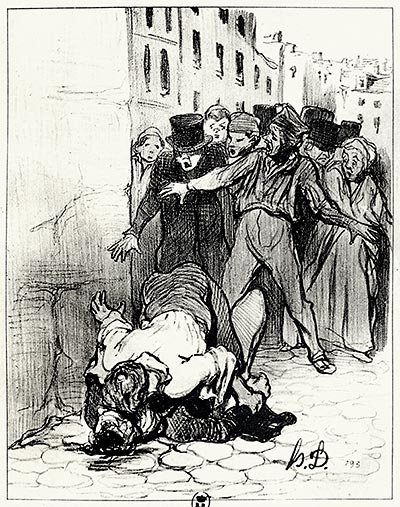
For Daumier these weaknesses are altogether ugly and grotesque, while for Gavarni they are either basely graceful or touchingly miserable; but the vision of them in both cases is close and direct. If, on the other hand, we look through a dozen volumes of the collection of Punch we get an equal impression of hilarity, but we by no means get an equal impression of irony. Certainly the pages of Punch do not reek with pessimism; their “criticism of life” is gentle and forbearing. Leech is positively optimistic; there is at any rate nothing infinite in his irreverence; it touches bottom as soon as it approaches the pretty woman or the nice girl. It is such an apparition as this that really, in Gavarni, awakes the scoffer. Du Maurier is as graceful as Gavarni, but his sense of beauty conjures away almost everything save our minor vices. It is in the exploration of our major ones that Gavarni makes his principal discoveries of charm or of absurdity of attitude. None the less, of course, the general inspiration of both artists is the same: the desire to try the innumerable different ways in which the human subject may not be taken seriously.
If this view of that subject, in its plastic manifestations, makes history of a sort, it will not in general be of a kind to convert those persons who find history sad reading. The writer of the present lines remained unconverted, lately, on an occasion on which many cheerful influences were mingled with his impression. They were of a nature to which he usually does full justice, even overestimating perhaps their charm of suggestion; but, at the hour I speak of, the old Parisian quay, the belittered print shop, the pleasant afternoon, the glimpse of the great Louvre on the other side of the Seine, in the interstices of the sallow estampes suspended in window and doorway—all these elements of a rich actuality availed only to mitigate, without transmuting, that general vision of a high, cruel pillory which pieced itself together as I drew specimen after specimen from musty portfolios.
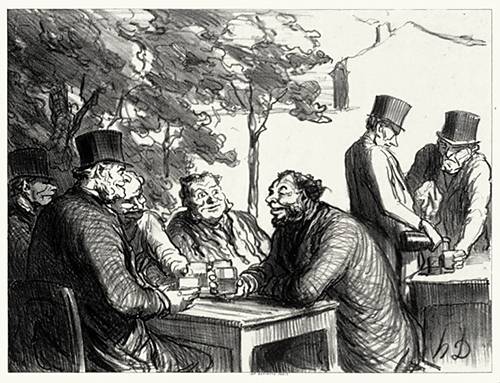
I had been passing the shop when I noticed in a small vitrine, let into the embrasure of the doorway, half a dozen soiled, striking lithographs, which it took no more than a first glance to recognize as the work of Daumier. They were only old pages of the Charivari, torn away from the text and rescued from the injury of time; and they were accompanied with an inscription to the effect that many similar examples of the artist were to be seen within. To become aware of this circumstance was to enter the shop and to find myself promptly surrounded with bulging cartons and tattered relics. These relics crumpled leaves of the old comic journals of the period from 1830 to 1855 are neither rare nor expensive; but I happened to have lighted on a particularly copious collection, and I made the most of my small good fortune, in order to transmute it, if possible, into a sort of compensation for my having missed unavoidably, a few months before, the curious exhibition de la Caricature Moderne held for several weeks just at hand, in the École des Beaux-Arts. Daumier was said to have appeared there in considerable force; and it was a loss not to have had that particular opportunity of filling one’s mind with him.
There was perhaps a perversity in having wished to do so, strange, indigestible stuff of contemplation as he might appear to be; but the perversity had had an honorable growth. Daumier’s great days were in the reign of Louis-Philippe; but in the early years of the Second Empire he still plied his coarse and formidable pencil. I recalled, from a juvenile consciousness, the last failing strokes of it. They used to impress me in Paris, as a child, with their abnormal blackness as well as with their grotesque, magnifying movement, and there was some thing in them that rather scared a very immature admirer.
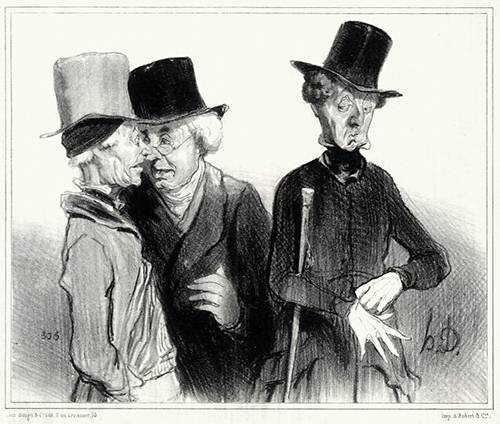
"There you go: you’ve got your private means, I’ve become a doctor, and he’s become a lion."
"What’s that?"
"It’s a sort of animal."
"Hush, he could hear us!"
"Don’t worry, he has no teeth left: it’s an old lion."
This small personage, however, was able to perceive later, when he was unfortunately deprived of the chance of studying them, that there were various things in them besides the power to excite a vague alarm. Daumier was perhaps a great artist; at all events unsatisfied curiosity increased in proportion to that possibility.
The first complete satisfaction of it was really in the long hours that I spent in the little shop on the quay. There I filled my mind with him, and there too, at no great cost, I could make a big parcel of these cheap reproductions of his work. This work had been shown in the École des Beaux-Arts as it came from his hand; M. Champfleury, his biographer, his cataloger and devotee, having poured forth the treasures of a precious collection, as I suppose they would be called in the case of an artist of higher flights. It was only as he was seen by the readers of the comic journals of his day that I could now see him; but I tried to make up for my want of privilege by prolonged immersion. I was not able to take home all the portfolios from the shop on the quay, but I took home what I could, and I went again to turn over the superannuated piles. I liked looking at them on the spot; I seemed still surrounded by the artist’s vanished Paris and his extinct Parisians. Indeed no quarter of the delightful city probably shows, on the whole, fewer changes from the aspect it wore during the period of Louis-Philippe, the time when it will ever appear to many of its friends to have been most delightful. The long line of the quay is unaltered, and the rare charm of the river. People came and went in the shop: it is a wonder how many, in the course of an hour, may lift the latch even of an establishment that pretends to no great business. What was all this small, sociable, contentious life but the great Daumier’s subject-matter? He was the painter of the Parisian bourgeois, and the voice of the bourgeois was in the air.
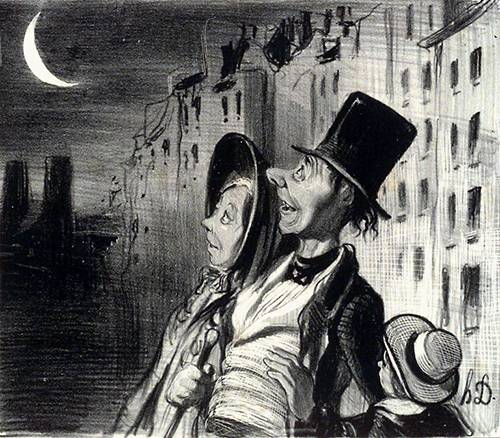
M. Champfleury has given a summary of Daumier’s career in his smart little Histoire de la caricature moderne, a record not at all abundant in personal detail. The biographer has told his story better perhaps in his careful catalog of the artist’s productions, the first sketch of which is to be found in L’Art for 1878. This copious list is Daumier’s real history; his life cannot have been a very different business from his work. I read in the interesting publication of M. Grand-Carteret (Les Mœurs et la caricature en France, 1888) that our artist produced nearly 4000 lithographs and a thousand drawings on wood, up to the time when failure of eyesight compelled him to rest. This is not the sort of activity that leaves a man much time for independent adventures, and Daumier was essentially of the type, common in France, of the specialist so immersed in his specialty that he can be painted in only one attitude—a general circumstance which perhaps helps to account for the paucity, in that country, of biography, in our English sense of the word, in proportion to the superabundance of criticism.
Honoré Daumier was born at Marseilles February 26th, 1808; he died on the 11th of the same month, 1879. His main activity, however, was confined to the earlier portion of a career of almost exactly seventy-one years, and I find it affirmed in Vapereau’s Dictionnaire des contemporains that he became completely blind between 1850 and 1860. He enjoyed a pension from the State of 2,400 francs; but what relief from misery could mitigate a quarter of a century of darkness for a man who had looked out at the world with such vivifying eyes? His father had followed the trade of a glazier, but was otherwise vocal than in the emission of the rich street cry with which we used all to be familiar, and which has vanished with so many other friendly pedestrian notes. The elder Daumier wrought verses as well as window panes, and M. Champfleury has disinterred a small volume published by him in 1823.
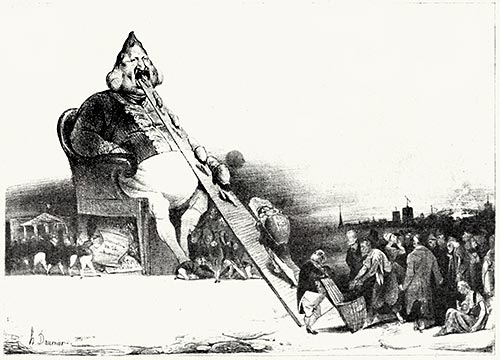
Louis-Philippe as Gargantua.
The merit of his poetry is not striking; but he was able to transmit the artistic nature to his son, who, becoming promptly conscious of it, made the inevitable journey to Paris in search of fortune. The young draughtsman appeared to have missed at first the way to this boon; inasmuch as in the year 1832 he found himself condemned to six months’ imprisonment for a lithograph disrespectful to Louis-Philippe. This drawing had appeared in the Caricature, an organ of pictorial satire founded in those days by one Philipon, with the aid of a band of young mockers to whom he gave ideas and a direction, and several others, of whom Gavarni, Henry Monnier, Decamps, Grandville, were destined to make themselves a place. M. Eugene Montrosier, in a highly appreciative article on Daumier in L’Art for 1878, says that this same Philipon was le journalisme fait homme; which did not prevent him—rather in fact fostered such a result—from being perpetually in delicate relations with the government. He had had many horses killed under him, and had led a life of attacks, penalties, suppressions and resurrections. He subsequently established the Charivari and launched a publication entitled L’Association Lithographique Mensuelle, which brought to light much of Daumier’s early work. The artist passed rapidly from seeking his way to finding it, and from an ineffectual to a vigorous form.
In this limited compass and in the case of such a quantity of production it is almost impossible to specify – difficult to pick dozens of examples out of thousands. Daumier became more and more the political spirit of the Charivari, or at least the political pencil, for M. Philipon, the breath of whose nostrils was opposition—one perceives from here the little bilious, bristling, ingenious, insistent man—is to be credited with a suggestive share in any enterprise in which he had a hand. This pencil played over public life, over the sovereign, the ministers, the deputies, the peers, the judiciary, the men and the measures, the reputations and scandals of the moment, with a strange, ugly, extravagant, but none the less sane and manly vigor.
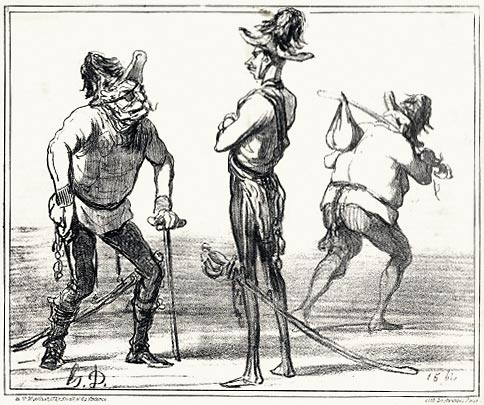
Old General Giulay replaced by young General Schlick:
"Giulay has proved with his military operations that he was blind… At least this one’s only one-eyed."
Daumier’s sign is strength above all, and in turning over his pages today there is no intensity of force that the careful observer will not concede to him. It is perhaps another matter to assent to the proposition, put forth by his greatest admirers among his countrymen, that he is the first of all caricaturists. To the writer of this imperfect sketch he remains considerably less interesting than Gavarni; and for a particular reason, which it is difficult to express otherwise than by saying that he is too simple. Simplicity was not Gavarni’s fault, and indeed to a large degree it was Daumier’s merit. The single grossly ridiculous or almost hauntingly characteristic thing which his figures represent is largely the reason why they still represent life and an unlucky reality years after the names attached to them have parted with a vivifying power. Such vagueness has overtaken them, for the most part, and to such a thin reverberation have they shrunk, the persons and the affairs which were then so intensely sketchable. Daumier handled them with a want of ceremony which would have been brutal were it not for the element of science in his work, making them immense and unmistakable in their drollery, or at least in their grotesqueness; for the term drollery suggests gayety, and Daumier is anything but gay. Un rude peintre de mœurs, M. Champfleury calls him; and the phrase expresses his extreme breadth of treatment.
Of the victims of his “rudeness” M. Thiers is almost the only one whom the present generation may recognize without a good deal of reminding, and indeed his hand is relatively light in delineating this personage of few inches and many episodes.
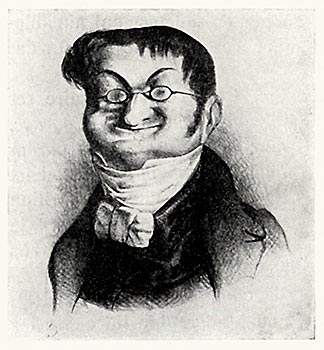
M. Thiers must have been dear to the caricaturist, for he belonged to the type that was easy to “do;” it being well known that these gentlemen appreciate public characters in direct proportion to their saliency of feature. When faces are reducible to a few telling strokes their wearers are overwhelmed with the honors of publicity; with which, on the other hand, nothing is more likely to interfere than the possession of a countenance neatly classical. Daumier had only to give M. Thiers the face of a clever owl, and the trick was played. Of course skill was needed to individualize the symbol, but that is what caricaturists propose to themselves. Of how well he succeeded the admirable plate of the lively little minister in a “new dress”—tricked out in the uniform of a general of the First Republic—is a sufficient illustration. The bird of night is not an acute bird, but how the artist has presented the image of a selected specimen! And with what a life-giving pencil the whole figure is put on its feet, what intelligent drawing, what a rich, free stroke! The allusions conveyed in it are to such for gotten things that it is strange to think the personage was, only the other year, still contemporaneous; that he might have been met, on a fine day, taking a few firm steps in a quiet part of the Champs-Élysées, with his footman carrying a second overcoat and looking doubly tall behind him. In what ever attitude Daumier depicts him, planted as a tiny boxing-master at the feet of the virtuous colossus in a blouse (whose legs are apart, like those of the Rhodian), in whom the artist represents the People, to watch the match that is about to come off between Ratapoil and M. Berryer, or even in the act of lifting the “parricidal” club of a new repressive law to deal a blow at the Press, an effulgent, diligent, sedentary muse (this picture, by the way, is a perfect specimen of the simple and telling in political caricature)—however, as I say, he takes M. Thiers, there is always a rough indulgence in his crayon, as if he were grateful to him for lending himself so well.
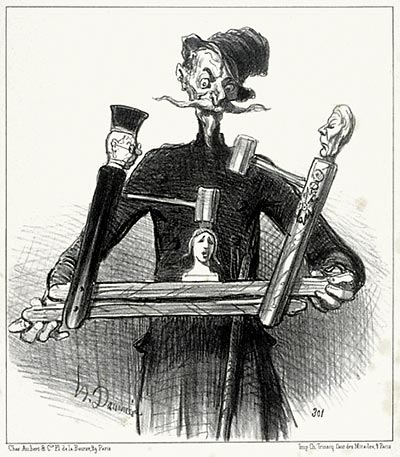
He invented Ratapoil as he appropriated Robert Macaire, and as a caricaturist he never fails to put into circulation, when he can, a character to whom he may attribute as many as possible of the affectations or the vices of the day. Robert Macaire, an imaginative, a romantic rascal, was the hero of a highly successful melodrama written for Frédérick Lemaître; but Daumier made him the type of the swindler at large in an age of feverish speculation – the projector of showy companies, the advertiser of worthless shares. There is a whole series of drawings descriptive of his exploits, a hundred masterly plates which, according to M. Champfleury, consecrated Daumier’s reputation. The subject, the legend, was in most cases, still according to M. Champfleury, suggested by Philipon. Sometimes it was very witty; as for instance when Bertrand, the muddled acolyte or scraping second fiddle of the hero, objects, in relation to a brilliant scheme which he has just developed, with the part Bertrand is to play, that there are constables in the country, and he promptly replies, Constables ? So much the better—they’ll take the shares !
Ratapoil was an evocation of the same general character, but with a difference of nuance—the ragged political bully, or hand-to-mouth demagogue, with the smashed tall hat, cocked to one side, the absence of linen, the club half-way up his sleeve, the swagger and pose of being gallant for the people. Ratapoil abounds in the promiscuous drawings that I have looked over, and is always very strong and living, with a considerable element of the sinister, so often in Daumier an accompaniment of the comic. There is an admirable page—it brings the idea down to 1851—in which a sordid but astute peasant, twirling his thumbs on his stomach and looking askance, allows this political adviser to urge upon him in a whisper that there is not a minute to lose—to lose for action, of course—if he wishes to keep his wife, his house, his field, his heifer and his calf. The canny skepticism in the ugly, half-averted face of the typical rustic who considerably suspects his counselor is indicated by a few masterly strokes.
This is what the student of Daumier recognizes as his science, or, if the word has a better grace, his art. It is what has kept life in his work so long after so many of the occasions of it have been swept into darkness. Indeed, there is no such commentary on renown as the "back numbers" of a comic journal. They show us that at certain moments certain people were eminent, only to make us unsuccessfully try to remember what they were eminent for.
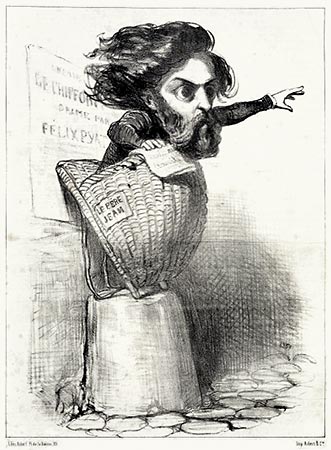
And the comparative obscurity (comparative, I mean, to the talent of the caricaturist) overtakes even the most justly honored names. M. Berryer was a splendid speaker and a public servant of real distinction and the highest utility; yet the fact that today his name is on few men’s lips seems to be emphasized by this other fact that we continue to pore over Daumier, in whose plates we happen to come across him. It reminds one afresh how Art is an embalmer, a magician, whom we can never speak too fair. People duly impressed with this truth are sometimes laughed at for their superstitious tone, which is pronounced, according to the fancy of the critic, mawkish, maudlin or hysterical. But it is really difficult to see how any reiteration of the importance of art can overstate the plain facts. It prolongs, it preserves, it consecrates, it raises from the dead. It conciliates, charms, bribes posterity; and it murmurs to mortals, as the old French poet sang to his mistress, You will be fair only so far as I have said so.
When it whispers even to the great, You depend upon me, and I can do more for you, in the long run, than any one else,
it is scarcely too proud. It puts method and power and the strange, real, mingled air of things into Daumier’s black sketchiness, so full of the technical gras, the “fat” which French critics commend and which we have no word to express. It puts power above all, and the effect which he best achieves, that of a certain simplification of the attitude or the gesture to an almost symbolic generality. His persons represent only one thing, but they insist tremendously on that, and their expression of it abides with us, unaccompanied with timid detail. It may really be said that they represent only one class—the old and ugly; so that there is proof enough of a special faculty in his having played such a concert, lugubrious though itbe, on a single chord.
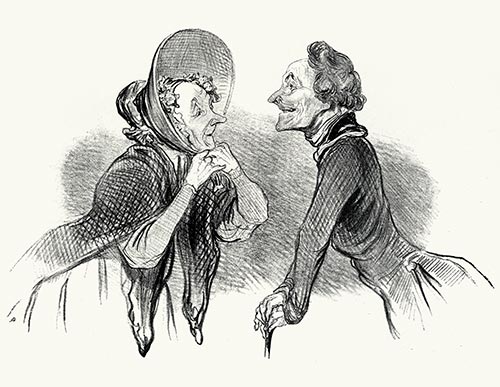
It has been made a reproach to him, says M. Grand-Carteret, that his work is lacking in two capital elements—la jeunesse et la femme;
and this commentator resents his being made to suffer for the deficiency—
as if an artist could be at the same time deep, comic, graceful and pretty; as if all those who have a real value had not created for themselves a form to which they remain confined and a type which they reproduce in all its variations, as soon as they have touched the aesthetic ideal that has been their dream. Assuredly, humanity, as this great painter saw it, could not be beautiful; one asks one’s self what a maiden in her teens, a pretty face, would have done in the midst of these good, plain folk, stunted and elderly, with faces like wrinkled apples. A simple accessory most of the time, woman is for him merely a termagant or a blue-stocking who has turned the corner.
When the eternal feminine, for Daumier, appears in neither of these forms he sees it in Madame Chaboulard or Madame Fribochon, the old snuff-taking, gossiping portress, in a nightcap and shuffling savates, relating or drinking in the wonderful and the intimate.
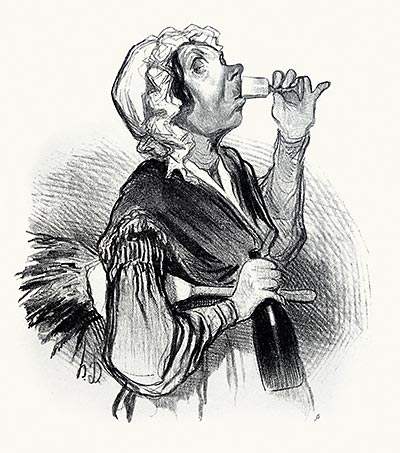
One of his masterpieces represents three of these dames, lighted by a guttering candle, holding their heads together to discuss the fearful earthquake at Bordeaux, the consequence of the government’s allowing the surface of the globe to be unduly dug out in California. The representation of confidential imbecility could not go further. When a man leaves out so much of life as Daumier—youth and beauty and the charm of woman and the loveliness of childhood and the manners of those social groups of whom it may most be said that they have manners—when he exhibits a deficiency on this scale it might seem that the question was not to be so easily disposed of as in the very non-apologetic words I have just quoted. All the same (and I confess it is singular), we may feel what Daumier omitted and yet not be in the least shocked by the claim of predominance made for him. It is impossible to spend a couple of hours over him without assenting to this claim, even though there may be a weariness in such a panorama of ugliness and an inevitable reaction from it. This anomaly, and the challenge to explain it which appears to proceed from him, render him, to my sense, remarkably interesting. The artist whose idiosyncrasies, whose limitations, if you will, make us question and wonder, in the light of his fame, has an element of fascination not attaching to conciliatory talents. If M. Eugene Montrosier may say of him without scandalizing us that such and such of his drawings belong to the very highest art, it is interesting (and Daumier profits by the interest) to put one’s finger on the reason we are not scandalized.
I think this reason is that, on the whole, he is so peculiarly serious. This may seem an odd ground of praise for a jocose draughts man, and of course what I mean is that his comic force is serious—a very different thing from the absence of comedy. This essential sign of the caricaturist may surely be any thing it will so long as it is there. Daumier’s figures are almost always either foolish, fatuous politicians or frightened, mystified bourgeois; yet they help him to give us a strong sense of the nature of man. They are sometimes so serious that they are almost tragic; the look of the particular pretension, combined with inanity, is carried almost to madness. There is a magnificent drawing of the series of Le public du Salon, old classicists looking up, horrified and scandalized, at the new romantic work of 1830, in which the faces have an appalling gloom of mystification and platitude.
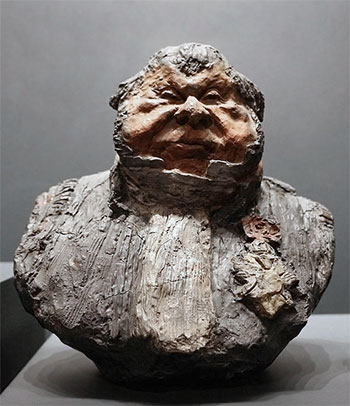
We feel that Daumier reproduces admirably the particular life that he sees, because it is the very medium in which he moves. He has no wide horizon; the absolute bourgeois hems him in, and he is a bourgeois himself, without poetic ironies, to whom a big cracked mirror has been given. His thick, strong, manly touch stands, in every way, for so much knowledge. He used to make little images, in clay and in wax (many of them still exist), of the persons he was in the habit of representing, so that they might constantly seem to be "sitting" for him. The caricaturist of that day had not the help of the ubiquitous photograph. Daumier painted actively, as well, in his habitation, all dedicated to work, on the narrow island of St. Louis, where the Seine divides and where the monuments of old Paris stand thick, and the types that were to his purpose pressed close upon him. He had not far to go to encounter the worthy man, in the series of Les papas, who is reading the evening paper at the cafe with so amiable and placid a credulity, while his unnatural little boy, opposite to him, finds sufficient entertainment in the much satirized Constitutionnel. The bland absorption of the papa, the face of the man who believes everything he sees in the newspaper, is as near as Daumier often comes to positive gentleness of humor. Of the same family is the poor gentleman, in Actualités, seen, in profile, under a doorway where he has taken refuge from a torrent of rain, who looks down at his neat legs with a sort of speculative contrition and says, "To think of my having just ordered two pairs of white trousers." The tout petit bourgeois palpitates in both these sketches.
I must repeat that it is absurd to pick half a dozen at hazard, out of five thousand; yet a few selections are the only way to call attention to his strong drawing. This has a virtuosity of its own, for all its hit-or-miss appearance. Whatever he touches—the nude, in the swimming-baths on the Seine, the intimations of landscape, when his petits rentiers go into the suburbs for a Sunday—acquires relief and character.
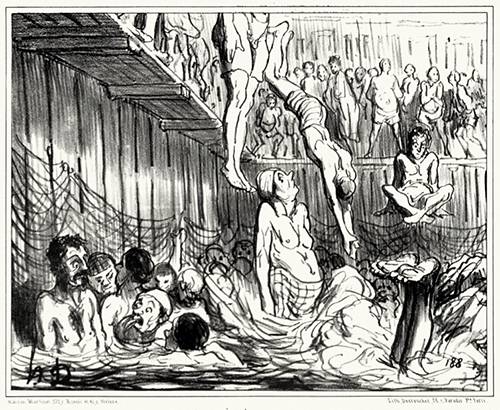
Docteur Veron, a celebrity of the reign of Louis-Philippe, a Maecenas of the hour, a director of the opera, author of the Mémoires d’un bourgeois de Paris—this temporary "illustration," who appears to have been almost indecently ugly, would not be vivid to us today had not Daumier, who was often effective at his expense, happened to have represented him, in some crisis of his career, as a sort of naked inconsolable Vitellius. He renders the human body with a cynical sense of its possible flabbiness and an intimate acquaintance with its structure. "Une Promenade Conjugale," in the series of Tout ce qu’on voudra, portrays a hillside, on a summer afternoon, on which a man has thrown himself on his back to rest, with his arms locked under his head. His fat, full-bosomed, middle-aged wife, under her parasol, with a bunch of field-flowers in her hand, looks down at him patiently and seems to say, "Come, my dear, get up." There is surely no great point in this; the only point is life, the glimpse of the little snatch of poetry in prose. It is a matter of a few broad strokes of the crayon; yet the pleasant laziness of the man, the idleness of the day, the fragment of homely, familiar dialogue, the stretch of the field with a couple of trees merely suggested, have a communicative truth.
I perhaps exaggerate all this, and in insisting upon the merit of Daumier may appear to make light of the finer accomplishment of several more modern talents, in England and France, who have greater ingenuity and subtlety and have carried qualities of execution so much further. In looking at this complicated younger work, which has profited so by experience and comparison, it is inevitable that we should perceive it to be infinitely more cunning. On the other hand Daumier, moving in his contracted circle, has an impressive depth. It comes back to his strange seriousness. He is a draughtsman by race, and if he has not extracted the same brilliancy from training, or perhaps even from effort and experiment, as some of his successors, does not his richer satiric and sympathetic feeling more than make up the difference?
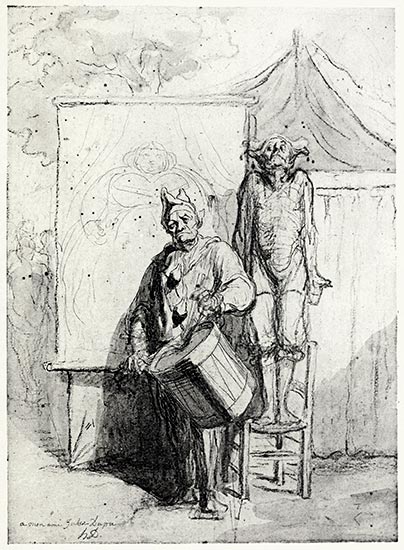
However this question may be answered, some of his drawings belong to the class of the unforgettable. It may be a perversity of prejudice, but even the little cut of the “Connoisseurs,” the group of gentlemen collected round a picture and criticizing it in various attitudes of sapience and sufficiency, appears to me to have the strength that abides. The criminal in the dock, the flat-headed murderer, bending over to speak to his advocate, who turns a whiskered, professional, anxious head to caution and remind him, tells a large, terrible story and awakes a recurrent shudder. We see the gray court room, we feel the personal suspense and the immensity of justice. The Saltimbanques, reproduced in L’Art for 1878, is a page of tragedy, the finest of a cruel series. M. Eugene Montrosier says of it that The drawing is masterly, incomparably firm, the composition superb, the general impression quite of the first order.
It exhibits a pair of lean, hungry mountebanks, a clown and a harlequin beating the drum and trying a comic attitude to attract the crowd, at a fair, to a poor booth in front of which a painted canvas, offering to view a simpering fat woman, is suspended. But the crowd doesn’t come, and the battered tumblers, with their furrowed cheeks, go through their pranks in the void. The whole thing is symbolic and full of grimness, imagination and pity. It is the sense that we shall find in him, mixed with his homelier extravagances, an element prolific in indications of this order that draws us back to Daumier.
This article was taken from Picture and Text written by Henry James and published by Harper, New York: 1893.
- Image sources:
The National Gallery of Canada; the Internet Archive (1, 2); Brooklyn Museum (1, 2, 3, 4, 5); Wikimedia Commons; the Fine Arts Museums of San Francisco; Sailko from Wikipedia
